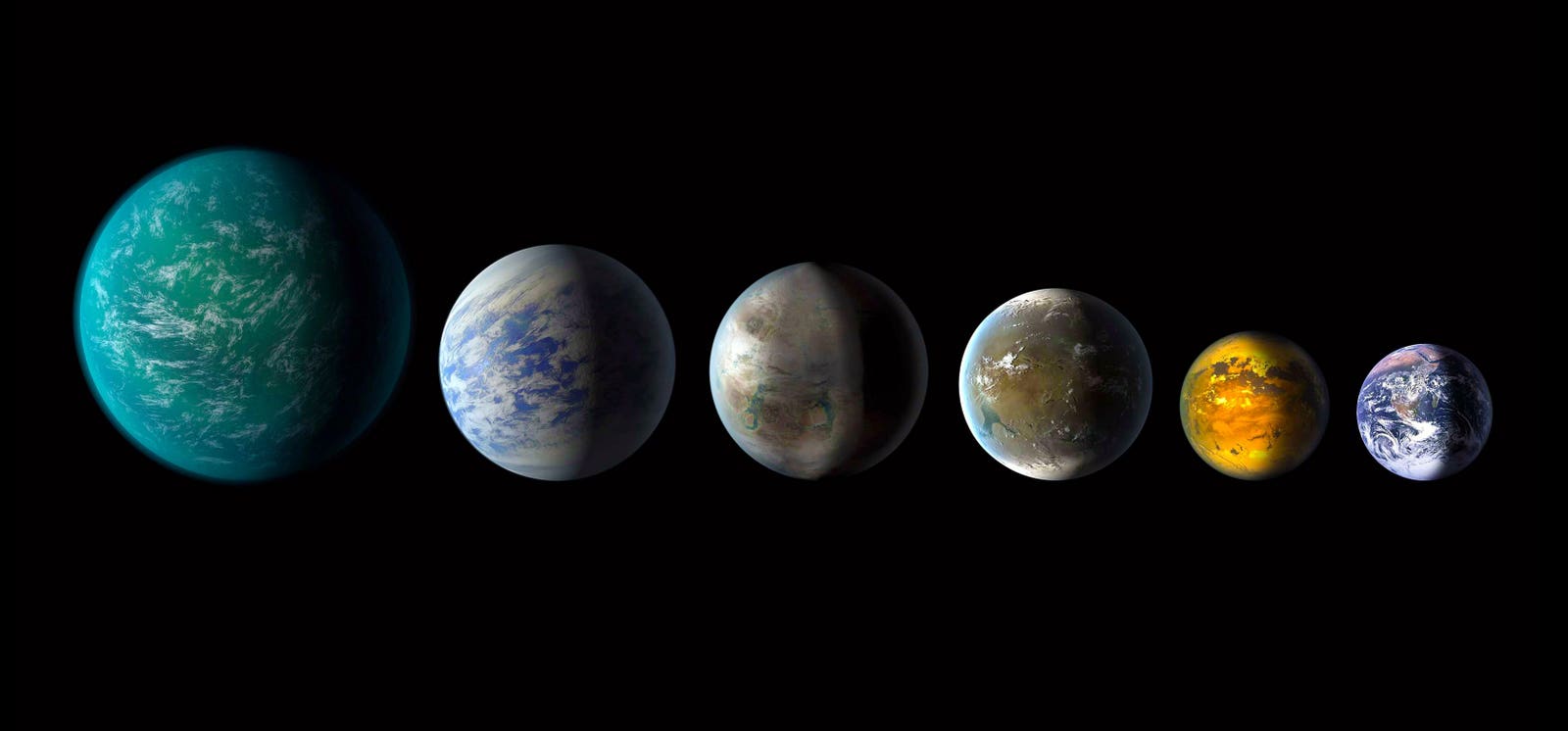Habitable zone exoplanets discovered by the Kepler Space Telescope – matching the Earth-Sun system – … [+] are prime targets for SETI “technosignature” searches ahead, say leading-edge astronomers. (Photo by: Universal History Archive/ Universal Images Group via Getty Images)
Universal Images Group via Getty Images
Astronomers heading the Search for Extraterrestrial Intelligence predict their quest might first spark an encounter with another world’s AI – an interplanetary emissary speaking in code.
With the discovery of more than 5000 planets revolving around other stars, and countless billions more projected to be spinning around the Milky Way, the chances of finding intelligent aliens appear to be rising.
While researchers surveying other solar systems once focused on detecting “biosignatures,” or chemical traces of even simple photosynthetic life, in the atmospheres of these exoplanets, scientists at the leading edge of the SETI campaign are now seeking “technosignatures,” or signs that an advanced civilization is transforming its globe.
Connected arrays of radio telescopes – featuring a large number of small dishes – “are becoming the design of choice for …both targeted and all-sky [SETI] searches,” says Jill Tarter, an astronomer who has been at the global forefront in conducting scans for signs of intelligent outposts across the galaxy.
As more globes are discovered, Tarter tells me in an interview, potentially habitable Earth-size planets around Sun-like stars will form the most promising targets for technosignature searches with these cutting-edge observatories.
When the next-generation Square Kilometer Array – stretching from South Africa to Australia – is activated, this “will be the first telescope with the sensitivity to detect Earth 2020-levels of radio “leakage” at interstellar distances,” Tarter explains in a fascinating study she co-authored with other scientists spearheading searches for hyper-technologies across the galaxy’s spiral disc of stars.
When activated, the Square Kilometer Array radio telescope could help humanity “detect a clone of … [+] itself on a planet around another star,” says astronomer Jill Tarter. AFP PHOTO / ALEXANDER JOE (Photo by ALEXANDER JOE / AFP) (Photo by ALEXANDER JOE/AFP via Getty Images)
AFP via Getty Images
In the paper “Nasa and the Search for Technosignatures,” Tarter says: “This is an important milestone in radio technosignature work, since it marks the first time that humanity will have the capability, in principle, to detect a clone of itself on a planet around another star.”
“As we learn to communicate with AI for our own benefits, we may become better in recognizing alien AI signals,” adds Tarter, cofounder of the Center for SETI Research at the SETI Institute in California.
A trailblazing planet hunter who inspired Carl Sagan’s blockbuster novel-turned-film Contact, Jill Tarter has also been eulogized in the captivating bio Making Contact: Jill Tarter and the Search for Extraterrestrial Intelligence, which describes her as “a scientific star across the globe.”
Trailblazing SETI astronomer Jill Tarter was the inspiration for Carl Sagan’s blockbuster … [+] novel-turned-film Contact, starring Jodie Foster (Photo by Francois Duhamel/Sygma via Getty Images)
Sygma via Getty Images
“A possibility exists that in the near future, some type of communication may happen between an Earth-based AI supported system and an extrasolar form of AI,” Tarter predicts.
It might be possible, she tells me in the interview, that the first breakthrough in detecting an off-world beacon of life might actually be via an alien artificial intelligence.
Extraterrestrial AI created by remarkably futuristic civilizations, she says, might have spread across the galaxy by now, especially around Sun-like stars that formed billions of years earlier than the Sun.
Professor Jason Wright, director of the Penn State Extraterrestrial Intelligence Center, agrees that the first contact between Earth-based scientists and technologists on another world might be with an exoplanet AI, and that artificial intelligence agents might have already crisscrossed an archipelago of celestial colonies.
A generation ago, he told me in an interview, NASA cut its funding for SETI research under the direction of Congress. One of the globe’s foremost astronomers in the drive to seek out oases of incredibly developed technologies and culture across this section of the cosmos, Wright headed the crusade to persuade the American space agency to restore its backing for these interstellar explorations.
Since the start of his campaign, he adds, both NASA and the National Science Foundation have begun awarding grants to leading SETI scholars. Wright, a professor of astronomy and astrophysics, has himself received a $483,000 NASA grant to conduct an edgy study titled “New Approaches to Laser and Radio Technosignatures,” set to begin at the start of 2025.
As space telescopes discover more Earth-like planets orbiting alien stars – like the TRAPPIST-1 … [+] solar system shown here – astronomers will zoom in to check for techno-signs of an advanced civilization. (Photo digital Illustration by NASA/NASA via Getty Images)
NASA via Getty Images
He has also played mentor, via his nationally acclaimed graduate courses in the Search for Extraterrestrial Intelligence, to an expanding constellation of SETI scientists who have in turn taken up prominent positions across American academia, all while weaving a web of connections to push forward the mission to reach scholars and inventors, explorers and physicists orbiting other stars.
Just as vanguard American space outfits are now perfecting the Starships to explore and terraform Mars, their celestial counterparts in more advanced societies are likely to launch never-ending waves of space odysseys to reach other star systems.
The expansion of hyper-tech civilizations across the cosmos should make the chances of detecting one of these ET outposts higher and higher with the passage of time, Professor Wright adds.
The discovery of intelligent life – even an extraterrestrial AI – moving out across the Milky Way would represent one of the most important leaps in human progress ever, he says, with consequences that change the future of the Earth and all its citizenry.
